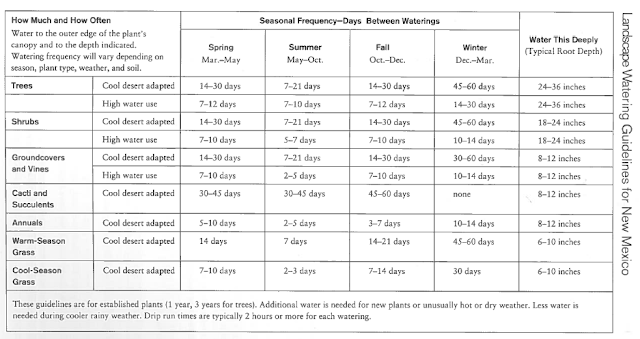Knowing How Much to Water, PART I: #itscomplicated
Southwest Yard and Garden
Knowing How Much to Water, PART I: #itscomplicated
In order to address the complicated question, I split this column into two weeks. This week I describe how the type of soil around your tree plays a big role in determining water requirements. CLICK HERE for Part II.
 |
Cottonwood leaf near Hillsboro, NM in September 2017. Although native to our region, cottonwood trees are no longer recommended for most of our ornamental landscapes because of their high water needs. Photo credit M. Thompson.
- Multiple Gardeners from All Over New Mexico
Even if you know the species of your tree and try to look up water requirements, you will likely find either a painfully vague answer like “moderate” or a complicated one. For example, in Judith Phillips’ revised New Mexico Gardener’s Guide the watering directions for desert willow are as follows “Until it reaches the desired height, water to a depth of two to three feet every two weeks when temperatures are above 90 degrees Fahrenheit, especially when the tree is flowering. Water once a month late spring through early fall, and every six weeks or less in winter…” Notice, she does not provide specific amounts of either water quantity or irrigation timing for each irrigation event. This is partly due to the variability of water output based on the type of irrigation equipment and water pressure, but also due to the huge variability of water capacity in different soil types. Phillips is also giving away a clue about general root structure, but we will learn more about that in a minute.
 |
| Irrigation scheduling table from "Arizona & New Mexico Getting Started Garden Guide" by Mary Irish and Judith Phillips, page 225. |
When
I first read Phillips’ water recommendations for different species, I wondered
how I could figure out how deep the water is moving in my soil. One way to do
this is to get a t-shaped rebar tool and push it down into the soil. The rebar
tip will move easily in moist soil and stop when it reaches dry soil. Many
gardeners use a screwdriver to test soil moisture up to the length of the
blade, so that is one easy place to start. Judy Nickell, a veteran Master
Gardener in Bernalillo County, recommends the long, narrow-bladed shovel for
moving a wedge of soil just enough to check soil moisture depth when you are
establishing your watering routine and when you suspect a problem.
This
is key: Roots will not grow through dry soil to find a water source. You read
that right! Roots grow where the soil is moist. Therefore, when you are
irrigating, it is crucial to apply water both where the roots currently are in
the soil as well as where you want them to grow.
Somewhere
along the way, most of us picked up the wrong idea for the shape of tree root
structures. That mental image of the underground root mass mirroring the above-ground
shape of the tree canopy is not accurate. Root systems often extend two to four
times the height of a given tree, if given the opportunity. Moreover, an
estimated 90% of tree roots that are actively absorbing water and nutrients can
be found in the top three feet of soil and 75% in the top foot.
Next week, check back for a discussion on irrigation needs based on tree species, age, canopy size, and more.
For more gardening information, visit
the NMSU Extension Horticulture page at Desert Blooms.
Send gardening questions to Southwest Yard and
Garden - Attn: Dr. Marisa Thompson at desertblooms@nmsu.edu,
or on social media: @NMDesertBlooms
Please copy your County Extension Agent and
indicate your county of residence when you submit your question!
Edible New Mexico Magazine article crosslink -- GROWING YOUR FUTURE FAVORITE TREE




Comments
Post a Comment